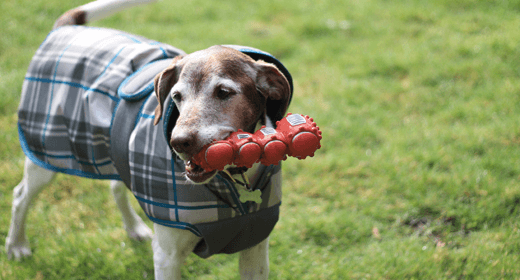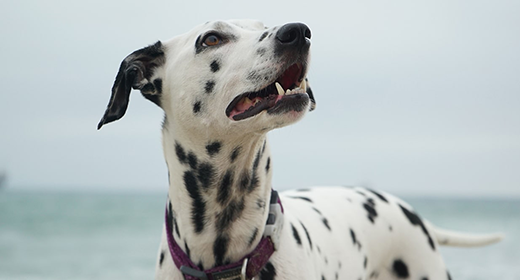

Your puppy's first visit to the vet will probably be more than just a quick hello. Get all the details from Veterinarian Dr. Katy Nelson as she talks about important details like how to properly bring your puppy into the vet's office and vaccinations he needs.
Your puppy's first veterinary checkup is about much more than simply greeting your dog's new vet, weighing in, and getting him his standard immunizations. Believe it or not, your first visit is just as much about educating yourself and answering your questions as it is about checking the health of your newest family member. Your first vet visit requires organization, preparation, and sometimes even some light note taking. Hi, I'm Dr. Katy Nelson with IAMS, and today we're talking about how to take your new puppy to his first veterinary appointment. Let's begin with what you'll need to bring to your first visit. First, you should find out what the breeder or shelter has already done for your puppy. They've probably given them some vaccinations. He probably has also been placed on a deworming schedule, and may even be on a heartworm preventative. And depending upon his breed, the tail may have been docked and the dewclaws removed. Your veterinarian will need all of this information, along with the puppy's approximate birth date. So it's important to bring all of your paperwork with you to your first veterinarian visit, so they can help you determine a schedule for completing immunizations, and determine when it's best to schedule spaying and neutering. Next you should bring a fresh stool sample to your first visit, so the veterinarian can check for parasites. Lastly, prepare a list of questions. After having your puppy home for a few days, there's no better time to ask questions than at your first visit with a medical professional. Ask other family members, too, if they have any questions that they'd like added to your list. Once you're prepared, bring your puppy's crate to the car, and do your best to secure it with available seat belts. Depending on the size and weight of the crate and the puppy, it's usually easier to secure the crate first, and then put your puppy inside. If you cannot fit a crate in your car, try purchasing a dog seat belt that is specifically designed to restrain and protect your puppy in case of an accident. This next piece of information is critical. Carry your puppy into the doctor's office. Do not let him interact with any other animals in the office. Though the other animals may be perfectly healthy themselves, your puppy can still get very sick from even just rubbing noses with another dog until his vaccinations and immunity against disease is further developed. After greeting you and your new pup, your vet will likely begin examining your pup as she continues to converse and answer your questions. She'll check your puppy's weight, temperature, heart, lungs, ears, genitals, eyes, nose, skin, anal region, mouth, and gums for both basic and breed abnormalities. Your puppy needs to learn to be comfortable being handled by others. Remaining calm and peaceful in the new environment with the vet or any other stranger will allow your puppy to do the same. Depending on the status of your puppy's records and stool exam, your puppy will also begin the deworming process, receive the following initial vaccines: rabies, distemper, and Bordatella. If your puppy's exposed to other dogs in boarding, public dog parks, training, and other situations, then based on geography and lifestyle, ask your veterinarian which vaccines they recommend for your puppy. Also, ask your vet about microchipping, and when it is safe to begin socializing and training your pup. Following the initial visit, your veterinarian will ask that you return to booster the vaccines until your puppy reaches a certain age. The time between boosters typically ranges between two and four weeks. Here are some signs that your puppy needs immediate medical care: allergic reactions or swelling around the face, hives-- this is most easily seen on the belly or face-- any eye injuries, any respiratory problems, any signs of pain-- panting, labored breathing, increased body temperature, lethargy, restlessness, or loss of appetite-- any suspected poisoning, any open wound, a seizure, fainting, or collapse, snake bites, thermal stress-- either too hot or too cold-- trauma, like if he's hit by a car, even if he seems fine, vomiting or diarrhea more than two or three times within an hour. I'm Dr. Katy Nelson with IAMS, and I hope that you found this helpful as you welcome your new addition to the family.


Some of the best indicators of your dog's health are its skin and coat conditions. A healthy dog coat should be shiny and smooth, not rough or brittle. When it comes to healthy skin, your dog's skin should be soft and smooth, not greasy or flaky. Good nutrition is one of the main factors in maintaining your dog’s health in terms of a luscious coat and soft skin. Apart from that, your dog’s coat and skin can also be taken care of through regular grooming and skincare routines that will help keep its hair free of tangles and its skin free of any irritation.
If you think that achieving healthy skin and healthy coat in dogs is difficult, it’s time for you to learn more about dog health and grooming. Let’s explore more about how you can achieve a healthy dog coat and skin for your floof.
The first thing that any pet parent thinks of when it comes to maintaining their dog’s skin and coat health is grooming. While grooming plays a significant role in making sure that your dog has a shiny coat and soft skin, health plays a bigger part in ensuring your floof’s appearance.
If you have been grooming your dog well and are still wondering why its coat and skin are not appearing the way they should, chances are that there is an internal issue. A shiny coat and supple skin on the outside start with a healthy dog on the inside. If your dog has flaky, bumpy, dull, or dry skin/coat, it could be an indicator that something is wrong. The first thing you need to do is book an appointment with your vet and cross out any underlying issues.
The skin is the largest organ of any animal's body. For dogs, most of their skin is covered with hair that sheds regularly or is constantly growing, in non-shedding breeds. Just like how we require a balanced diet full of high-quality digest table food types to keep our skin and hair in a healthy state, dogs also need to maintain their diet and make sure that their body is receiving the right amount of calories each day to maintain energy levels. If a dog is not eating well or is eating poor-quality food, its body will take longer to eliminate the waste products and cause the kidneys and liver to work twice as hard.
That being said, good nutrition is key to a healthy dog coat and skin. A dog that meets its dietary needs every day will boast soft, supple skin, and luscious, glowing hair.
Many pet parents struggle with maintaining their dog's skin and find it to be one of the most difficult tasks. In reality, achieving goals as such is fairly easy, provided you feed your dog the right nutrients and make sure that its diet meets its bodily requirements. Here are a few things you can do to maintain a healthy dog coat and skin:
Your dog needs to maintain a complete and balanced diet to achieve healthy skin and a glossy coat. Proteins, fats, carbohydrates, minerals, and vitamins need to be fed to your dog in balanced ratios. It is very important for dogs to meet their daily calorie intake so that they have enough energy to facilitate new hair growth and skin cell turnover. If your dog's diet is not easily digestible or contains poor-quality ingredients, it may not be able to create enough energy through its diet. Make sure that everything you feed your dog contains high-quality ingredients and does not pose a risk to your dog's health.
There are so many supplements available in the market today. While you may get confused between jars and bags of supplements promoted for healthy coat growth in dogs, the majority of these products contain a source of omega-3 fatty acids combined with a range of other ingredients. Omega-3 fatty acids have scientifically proven to be one of the most beneficial supplements that you can give your dog for a glossy coat and smooth skin. Omega-3 fatty acids are not just effective anti-inflammatory agents but are also capable of bulking up your dog’s skin’s natural fatty acid barrier to add that extra shine.
Bathing your dog is extremely important as it will remove any dust, debris, dirt, and odour from its skin and coat. If there are any allergens on your dog's skin, a good bath is the solution to this irritating problem. Generally, dogs should be bathed every 2 to 4 weeks depending on their breed's needs. If your vet has advised a different routine, make sure you follow that. It is best not to bathe your dog too much because that can result in flaky skin and can dry out your dog's coat. If your dog has any allergies or does not react well to a dog shampoo or soap, consult your vet and find the right products for your floof.
Dogs that suffer from allergies experience inflammation in their skin that can cause redness and itchiness. This makes them itch and scratch which ruptures their skin barrier, allowing other infections to enter your floof’s body. Unfortunately, allergies cannot be cured and can only be treated. For this reason, it’s important to know how to manage your dog's allergies by consulting a wet.
Fleas and ticks are the most common parasite irritants that will affect your dog's skin at some point in its life. These parasites can cause intense scratching, chewing, and biting of the skin. These acts of self-inflicted trauma can lead to tears in the skin barrier, leaving your dog with crusty, irritable, and red skin. Additionally, some fleas and ticks carry illnesses that can be fatal. It is best to keep your dogs protected against these parasites all around by consulting a vet and doing the needful.
Maintaining overall health for your dog to achieve a shiny coat and soft skin is extremely important. Make sure your dog is being fed a balanced diet and the right nutrients. it is also important for your dog to have a good exercise routine so that it is just not lazing around the house. A dog that is well rested, well fed, and receiving the right nutrients is set to flaunt healthy dog skin and coat.
It is imperative that pet parents keep good food for dog skin in mind and also administer nutrients that aid in a shiny, glossy coat. Now that you know what you need to do as a responsible pet parent, you are all set to give your floof its best life.